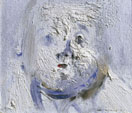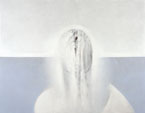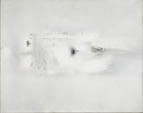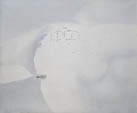In the summer of 1955, the artist is commissioned to
tour Spain by Ambassador magazine on behalf of the British textile
trade. Accompanied by the photographer Jay, travels to Granada, Cordoba,
Segovia, Madrid, Seville, noting numerous impressions for textile designs.
The artist's discovery there of a 'persistent visual tension', is translated
into numerous patterns drawn from a wide range of sources, including cobblestones,
sickles, stucco in village walls, and Azulejos in El Greco's Toledo
house. Contributes Pattern in Contrast: Hot, Dull-Cool, Bright,
'a colour impression by Louis le Brocquy' (Ambassador, No 10, London
1955). Three leading textile firms issue the designs: David Whitehead,
Furnishing prints; Seckers', woven silks, and Horrockses, Fashion prints,
one famously worn by Princess Margaret. Inspired by the violent contrast
of sun seen through lattice blinds in Andalusia, designs Sol Y Sombra (1955), the seventh tapestry to date, conceived to hang vertically or horizontally
as evidenced by date and signature. Identified as le Brocquy's only abstract
work, the design coincides with a momentous change about to take place
in his painting. The extensive tour of Spain in the summer of 1955, signals
a turning point in the work. The summer of 1955 signals a turning point
in the work: 'One day while passing through a village in La Mancha in shimmering
heat, I stopped spellbound before a small group of women and children standing
against a whitewashed wall. Here the intensity of the sunlight had interposed
its own revelation, absorbing these human figures into its brilliance,
giving substance only to shadow. From that moment I never perceived the
human presence in quite the same way. I had witnessed light as a kind of
matrix from which the human being emerges and into which it ambivalently
recedes with which it even identifies'. Le Brocquy's revelatory vision
of whiteness is curiously echoed by an earlier experience while living
at Albert Studios, recorded by Anne Madden: 'Snow had blanketed the city
during the night. He woke to a white world with no relation to yesterday's
actuality, silent, unmarked, as he walked out in the morning and crossed
Albert Bridge Road into Battersea Park. As he moved through the stillness
of the other world without footprint, the only sound the thump of snow
from an overweighted bough, under the little bridge he was crossing a heron
rose suddenly from the matrix of snow, hung in the air quite still for
a moment, then flapped away in slow motion.' ... |

























